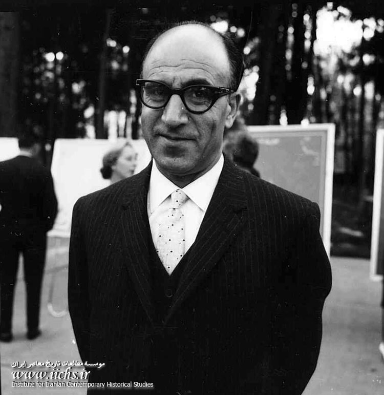


Ali Asghar Amirani
Born: 1915 bijar
Died: June 21, 1981
Field of activity: Journalism, magazine, weekly ...
Born: 1915 bijar
Died: June 21, 1981
Field of activity: Journalism, magazine, weekly ...
Khandaniha Magazine
The International Institute of Social History has received a complete range of Khandaniha, a Persian-language magazine published from 1940 to 1979 in Iran (Tehran). This collection is comprised of 3472 issues in an orderly series, and takes up eight and a half meters of shelf space.

The first issue of Khandaniha was published and distributed on September 16, 1940, in Tehran. Its publication continued in Tehran for almost 40 years, until after the Islamic Revolution. In its first years it was published in a small format, but gradually the appearance and size of the magazine changed and the number of pages increased. The magazine was also published in a different color as well.
Mr. Ali Asghar Amirani (1915 -1981), a graduate of Tehran University's faculty of law, was the founder, editor, and head of Khandaniha. He was of Kurdish origin.At the start of Iran's Islamic Revolution, he was executed by hanging (June 21, 1981).

Khandaniha was an important political and informational magazine. It offered a digest of articles from other Iranian publications. The editor-in-chief of the magazine wrote in its first issue: "Over the several years of my service in the mass media, I observed that many interesting articles were being published in the country's press. But either from a lack of opportunity or lack of accessibility people were deprived of reading them. Khandaniha contains very important readable articles selected from hundreds of country's different scientific, educational, social, economic, health, sport, and recreational articles published in newspapers and magazines in Tehran and other cities. The articles appear with the name of the source, the writer, or translator."
In the course of Khandaniha's existence, Iran witnessed many important historical events. From September 1941 until April 1946, Iran was occupied by allied forces. After the occupation the government of Reza Shah Pahlavi was forced to leave the country. Political parties and groups were established and many newspapers and magazines were founded. Iran's petroleum industry was nationalized on March 20, 1950. In August 1953, as a result of a coup d'état supported by the US and England, the government of Dr. Mussadeq was toppled, and oppression of leftist and nationalist forces increased. In the 1950s and 60s, Mohammad Reza Shah Pahlavi began to institute some reforms from above. Popular dissatisfaction spread, which came to a head in the 1978 revolution.
The events of this era were reflected and recorded in Khandaniha. In the course of the various social changes, the policy of the magazine also changed. In the beginning the magazine was sympathetic to the propaganda of the monarchy. After the second half of the 1970s, when political crises multiplied and the opposition to the state increased, the magazine tried to distance itself from the monarchy and took a position closer to the opposition. On February 3, 1979. the editor-in-chief of Khandaniha congratulated the Islamic Revolution of Iran and published the photo of Ayatollah Khomeini on its cover.


Newspapers and magazines are one of the main research sources of the contemporary history of Iran, and Khandaniha provides a clear sense of the political and social atmosphere from 1940 to 1979. The magazine is rich in information about two important aspects: first, the nationalization of petroleum and the designation of Dr. Mohammad Mussadeq as prime minister, from 1951 until the coup d'état of August 1953, and second, the period of the Iranian Revolution of 1978 -1980, which resulted in the establishment of the Islamic Republic of Iran. Ali Asghar Amirani, the editor-in-chief of "Khandaniha," was arrested on June 21, 1981, and was released in the summer of 1979. During his imprisonment publication of Khandaniha ceased. A few years after Amirani was released, he was arrested again, and he was executed on July 22, 1981. The last issue of Khandaniha appeared on August 28, 1979, in Tehran.

In 2008 a book was published in four volumes in Tehran containing a list of articles as well as the complete contents of Khandaniha on Iranian contemporary history. It has 20,966 historic articles.
A complete range of Khandaniha is available at the International Institute of Social History,
Text: N. Kawyani
socialhistory-
------------

Khandaniha was a weekly publication of critical political analysis founded in 1940 by Ali Asghar Amirani. Ali Asghar Amirani was arrested on March 12,1979, a month after the Islamic revolution, during the trial of the former Prime Minister Hovayda. Amirani was released in July, 1979, but was arrested again a few months later. After more than a year in jail, Amirani was executed by firing squad on June 21, 1981, the only journalist executed in Iran ever!
Khandaniha had much influence with intellectuals, and consisted of extracts and collections of foreign and Persian articles as well as commentary by the editor and publisher, Ali Asghar Amirani himself.
On 8 April, 1981, Amnesty International wrote to the Iranian Embassy in London, asking to be informed of the charges against the imprisoned Ali Asghar Amirani, proprietor and editor-in chief of the former weekly journal Khandaniha. No further information about Ali Asghar Amirani reached Amnesty International by the end of April 1981.
After Amirani's execution, opportunists around the world have named various publications Khandaniha, but they are not affiliated in any way with the the real Khandaniha Magazine.
Ali Asghar Amirani: born 1916 and executed June 21, 1981.
The Khandaniha foundation consists of the Khandaniha publications, Khandaniha magazine, Khandaniha news, and Khandaniha press.


